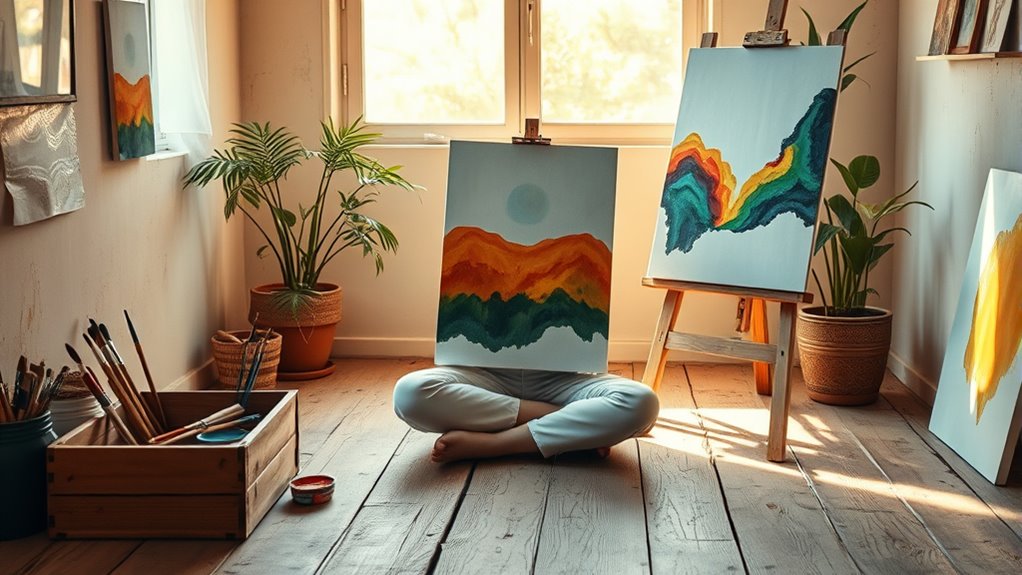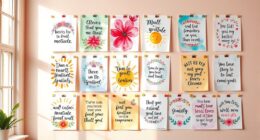Mindfulness can transform your artistic practice by enhancing creativity, emotional regulation, and focus. By being present, you’ll reduce distractions and increase your cognitive flexibility. You’ll find it easier to express yourself freely and explore new ideas without judgment. This calm mindset boosts your productivity and helps manage stress effectively. If you want to discover more ways mindfulness can elevate your art, you’ll find plenty of insightful techniques to inspire your creative journey.
Key Takeaways
- Mindfulness enhances focus and reduces distractions, allowing artists to immerse fully in their creative process.
- Practicing mindfulness fosters emotional regulation, aiding artists in managing stress and anxiety during their work.
- Engaging in expressive arts mindfully helps explore emotions without judgment, deepening connection to one’s art.
- Techniques like breath awareness and body scans can boost concentration and enrich the artistic experience.
- Regular mindfulness practice inspires fresh perspectives, increasing creativity and artistic productivity over time.
Understanding Mindfulness and Its Impact on Creativity
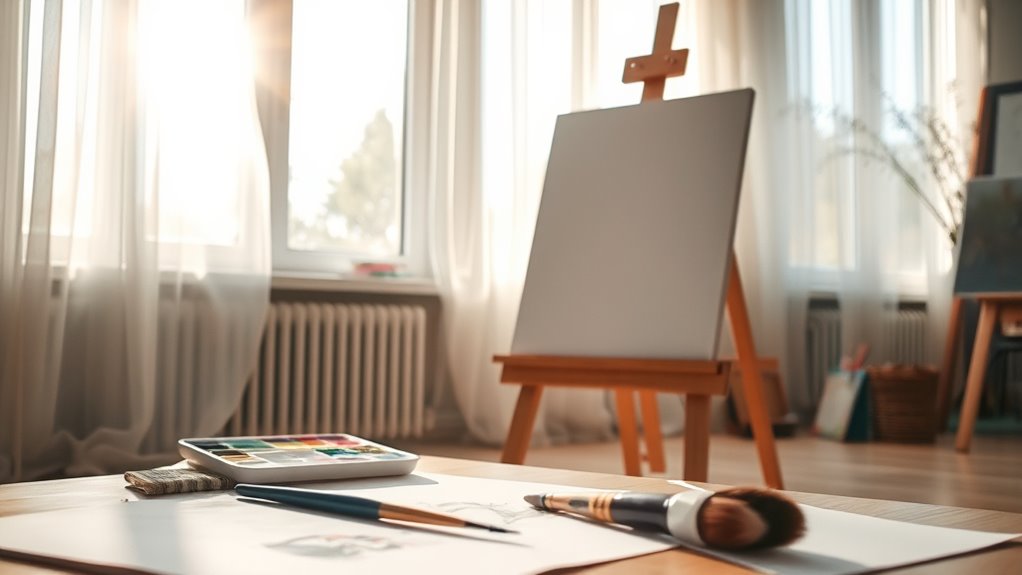
While you might think of mindfulness as just a relaxation technique, it goes much deeper, especially for artists. Mindfulness means being fully present and aware of the moment without judgment.
By practicing mindfulness through meditation or mindful breathing, you can enhance your creativity. It reduces distractions and improves focus, allowing you to dive deeper into your artistic process.
Mindfulness also boosts cognitive flexibility and emotional regulation, helping you manage stress and anxiety—common barriers to creativity. By fostering a beginner’s mind, it encourages exploration and new experiences.
As you develop these skills, you’ll likely find that your creative potential expands, empowering you to express your unique voice and vision with confidence and authenticity.
Benefits of Mindfulness for Artists
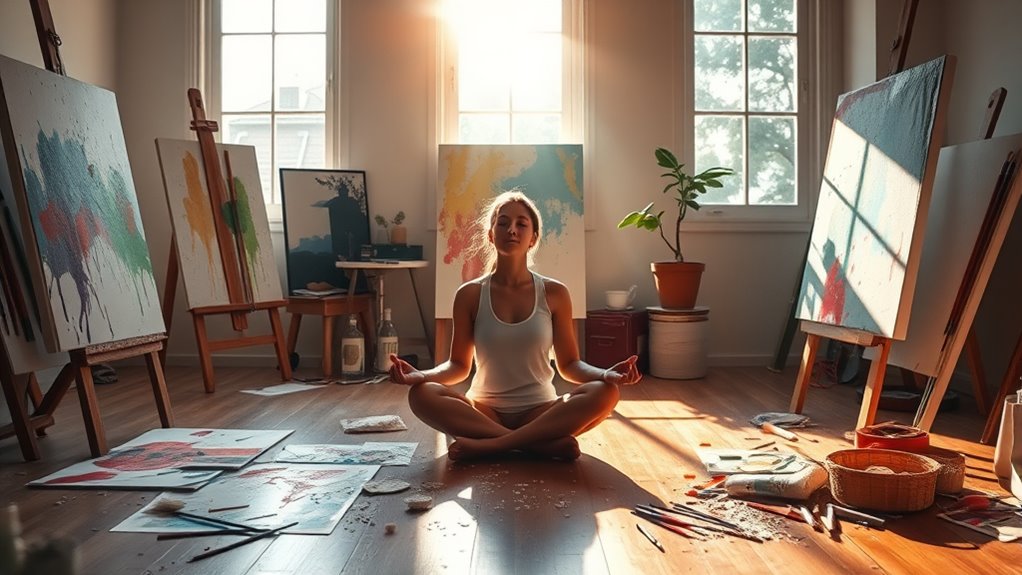
Mindfulness offers a wealth of benefits for artists, enhancing both their creative process and overall well-being. By staying present, you can immerse yourself in the moment, allowing your creativity to flow.
Regular mindfulness practice sharpens your focus, helping you seamlessly shift between intricate details and the broader vision of your work. It also clarifies your priorities, making project management smoother.
Mindfulness enhances focus and clarity, enabling seamless transitions between details and the bigger picture in your creative projects.
Additionally, mindfulness fosters emotional stability, creating space between negative thoughts and self-awareness. You might even experience a flow state, boosting creativity and productivity.
Ultimately, embracing mindfulness empowers you to express yourself freely, reduces stress, and deepens your connection to your art, enriching your artistic journey.
Exploring Mindfulness-Based Art Therapy
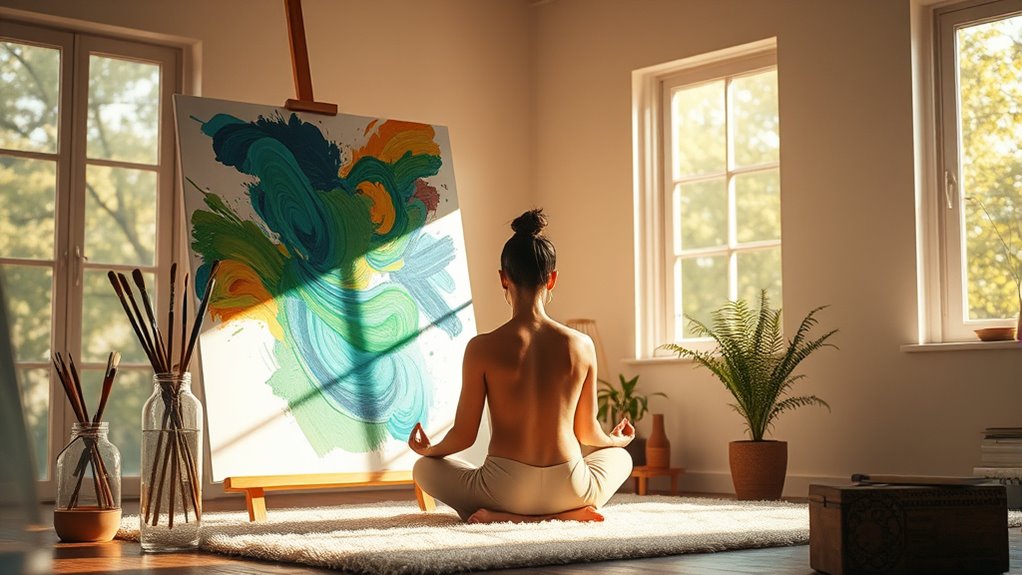
Art therapy can transform your creative journey by blending mindfulness practices with artistic expression.
Mindfulness-Based Art Therapy (MBAT) enhances your self-awareness and emotional processing through art-making. Whether in individual or group sessions, a therapist guides you in a supportive environment.
You’ll engage in mindful doodling, color breathing, and other techniques that promote relaxation and stress reduction. These practices encourage you to explore emotions without judgment, fostering a deeper understanding of yourself.
By focusing on the process rather than the outcome, you can experience creative freedom and develop emotional resilience.
Integrating mindfulness into your art practice not only improves self-esteem but also nurtures compassion for yourself and others, ultimately enriching your artistic journey.
The Role of Mindfulness in Artistic Processes
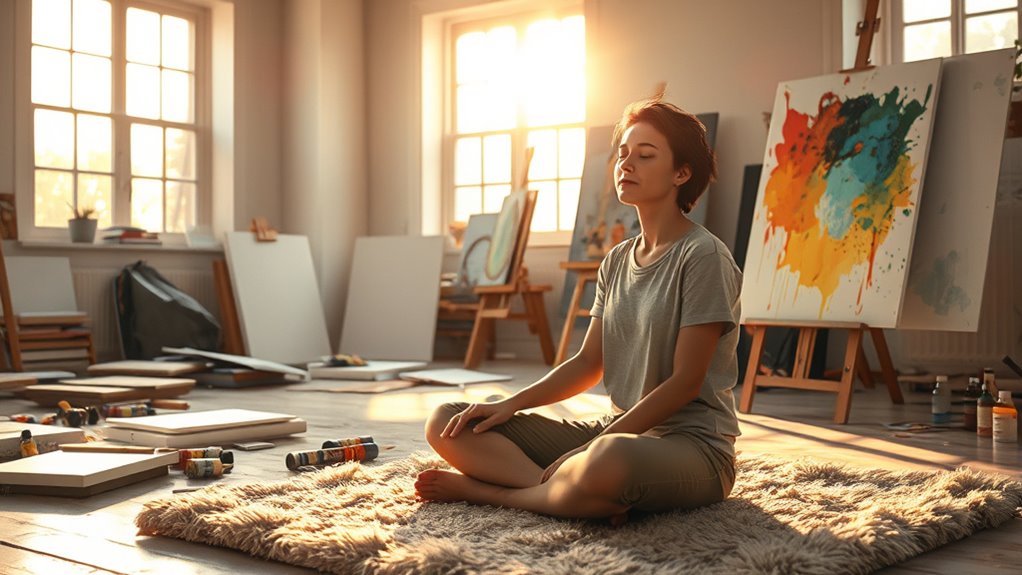
Creating art can often feel overwhelming, especially when faced with self-doubt or external pressures.
Mindfulness plays a vital role in your artistic process by enhancing focus, helping you concentrate on your work while minimizing distractions. It supports emotional regulation, allowing you to manage feelings that may arise during creation, leading to more balanced outcomes.
Engaging in mindfulness practices can spark inspiration and motivation, pushing you to explore new ideas. By reducing self-criticism, mindfulness fosters an open mindset, encouraging creativity.
Additionally, it helps you enter a flow state, where you’re fully immersed in your art. Incorporating mindfulness techniques like deep breathing or reflective journaling can significantly enrich your artistic experience and expression.
Neurological Effects of Mindfulness on Art Making
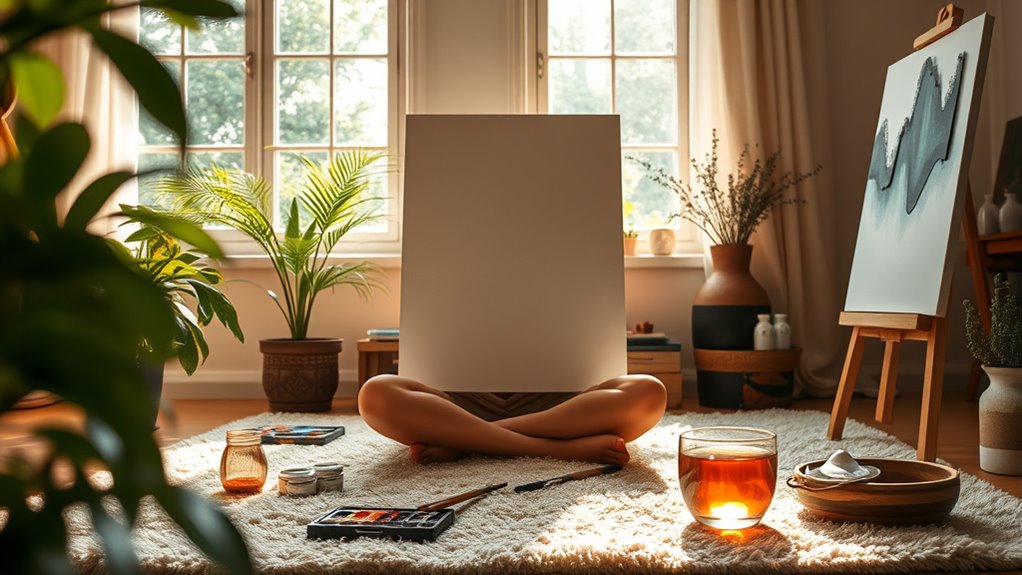
While engaging in art, you may not realize that your brain is undergoing significant changes. Creating art stimulates both hemispheres, reducing stress and promoting happiness.
As you immerse yourself in the process, you develop neural pathways that enhance your focus, attention, and memory. Mindfulness in art-making also allows you to express and process emotions non-verbally, boosting your mental well-being.
This practice can lead to relaxation, reducing anxiety and even lowering your heart rate. You might find yourself entering a flow state, providing a much-needed mental break. Additionally, incorporating mindfulness techniques can help in overcoming imposter syndrome, allowing artists to embrace their unique creative voice.
Over time, these activities can contribute to thicker gray matter areas, promoting neuroplasticity and cognitive health, ensuring that your mind remains sharp and engaged throughout your artistic journey.
Techniques for Implementing Mindfulness in Artistic Practice
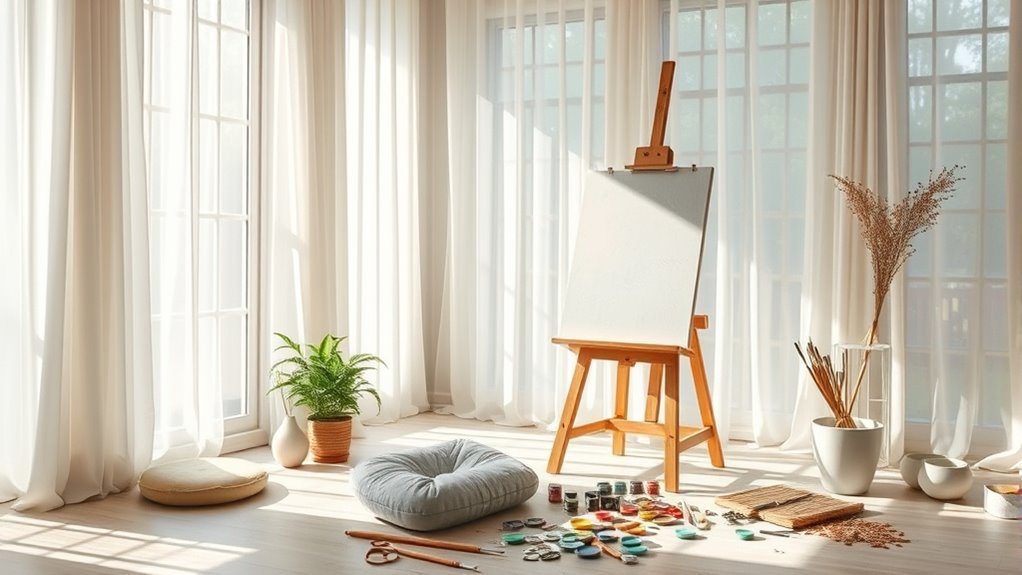
Mindfulness can transform your artistic practice in several meaningful ways. First, focus on the process of creating rather than the final product. This shift allows you to develop non-judgmental awareness, enhancing your creative flow.
Experiment with various art forms like painting, drawing, or collage, and incorporate mindfulness into each activity. Engage in expressive arts to explore your emotions without judgment, using techniques like intuitive drawing.
Regularly set aside time for mindfulness-based art activities, integrating practices such as breath awareness or guided meditation into your routine. You can also try body scan drawings or contemplative photography to deepen your focus.
Incorporate mindfulness into your art routine with breath awareness, guided meditation, or body scan drawings for deeper focus and connection.
These techniques will help you connect more authentically with your creativity and experience the therapeutic benefits of art.
Mindfulness and Stress Reduction for Artists
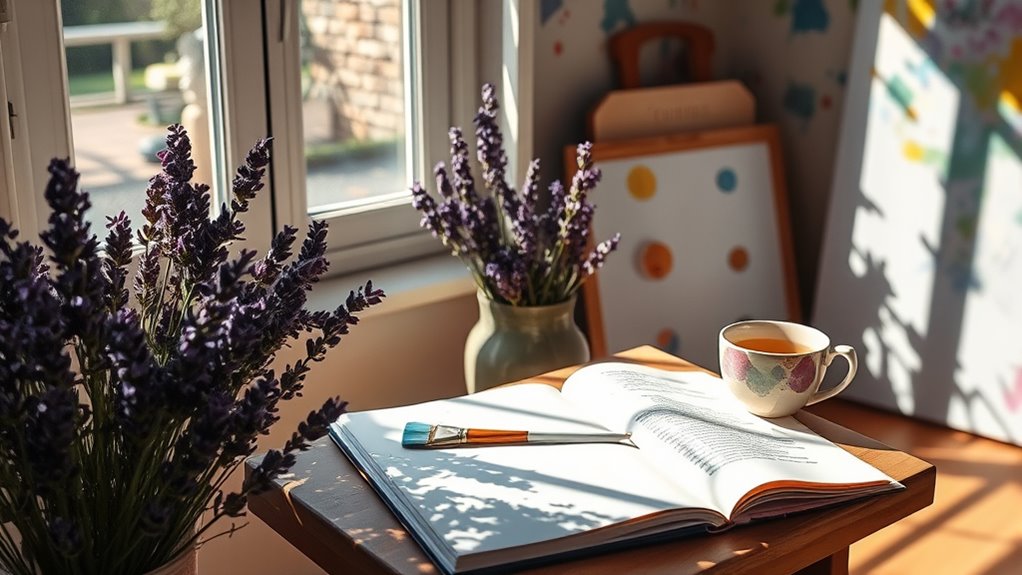
Integrating mindfulness into your artistic practice not only enriches creativity but also serves as a powerful tool for stress reduction.
Mindfulness-Based Art Therapy (MBAT) effectively lowers stress levels by combining mindfulness exercises with art-making. This approach encourages present-moment awareness, allowing you to process emotions and reduce anxiety.
Engaging in art, whether through painting or sculpting, activates different sensory experiences that enhance your neural processing and promote relaxation. Regular practice alters biological stress markers, helping you manage stress responses better.
Techniques like decentering, where you recognize thoughts as fleeting, can further alleviate anxiety. By embracing mindfulness in your art, you cultivate deeper awareness and trust in yourself, significantly boosting your overall well-being. Additionally, incorporating nutritional support from foods rich in omega-3 fatty acids can further enhance cognitive function and emotional resilience.
Enhancing Focus and Concentration Through Mindfulness
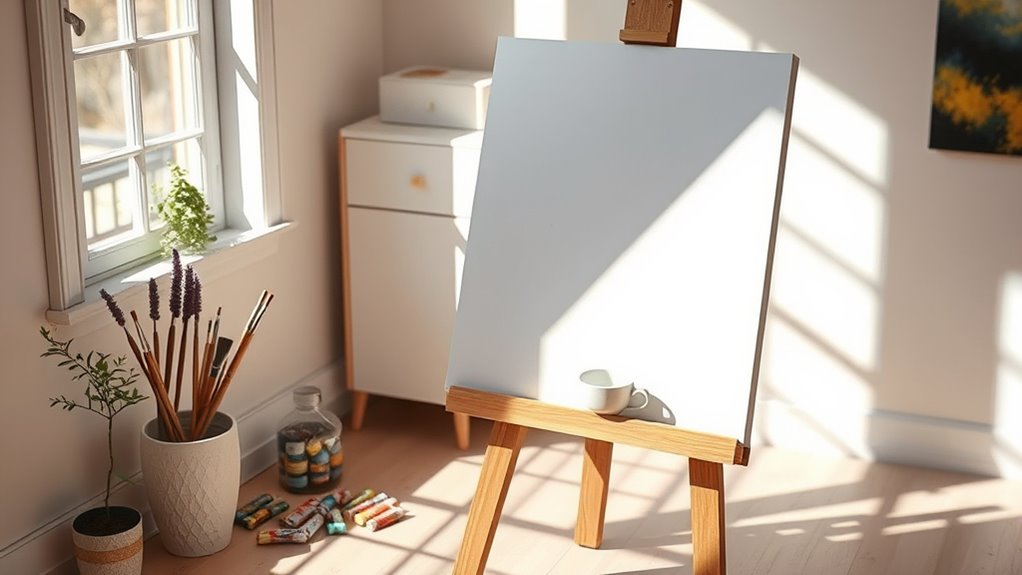
When you practice mindfulness, it sharpens your focus and concentration, allowing you to engage more fully in your artistic endeavors. By being fully present and aware, you reduce distractions that often hinder your creative flow.
Regular mindfulness techniques, such as meditation and body scans, cultivate your attention control, making it easier to immerse yourself in your work. Research shows mindfulness can even protect your brain from age-related declines, enhancing cognitive functions vital for sustained focus.
As you incorporate mindfulness into your art, you’ll find it helps manage distractions and fosters a more intentional approach to your creative process. Embracing this practice can unlock deeper creative potential, resulting in more focused and fulfilling artistic experiences. Furthermore, seeking support during challenging times can enhance your mindfulness practice, providing additional tools to boost your focus and creativity.
The Connection Between Mindfulness and Emotional Regulation
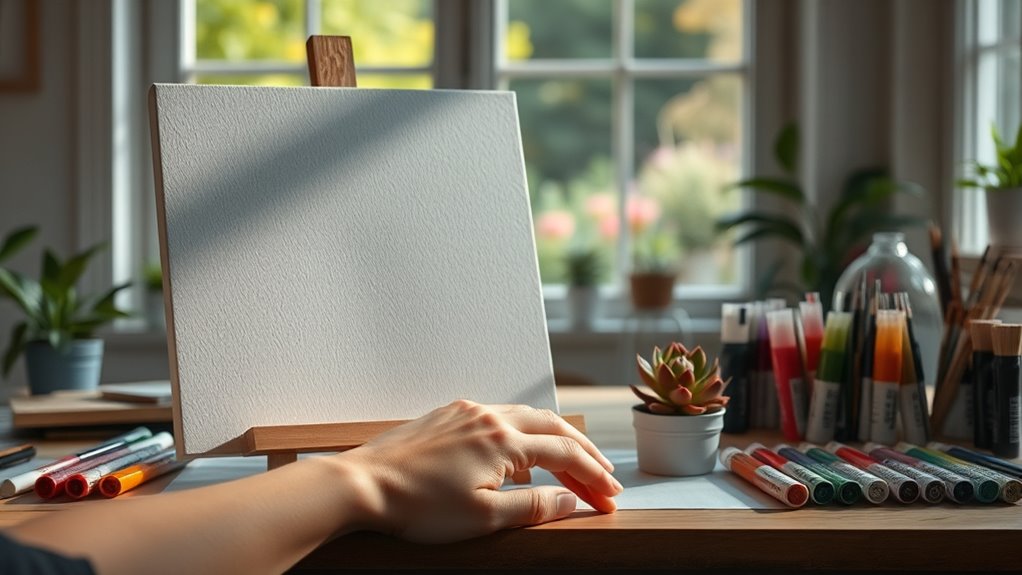
Although many artists focus on their technical skills, embracing mindfulness can significantly enhance your emotional regulation.
Mindfulness helps you stay present, allowing you to observe your thoughts and feelings without judgment. This awareness is crucial for managing emotional responses, as it provides strategies to increase or decrease your emotional intensity.
Engaging with art as a mindful practice facilitates emotional expression, helping you explore your inner landscape. Mindfulness-based interventions (MBIs) have shown to improve emotional reactivity and reduce rumination.
By fostering brain connectivity and activating areas linked to emotion processing, mindfulness trains you to respond to emotions more effectively.
Ultimately, integrating mindfulness into your artistic practice can lead to greater emotional balance and mental well-being.
Long-Term Benefits of Mindfulness for Artistic Growth
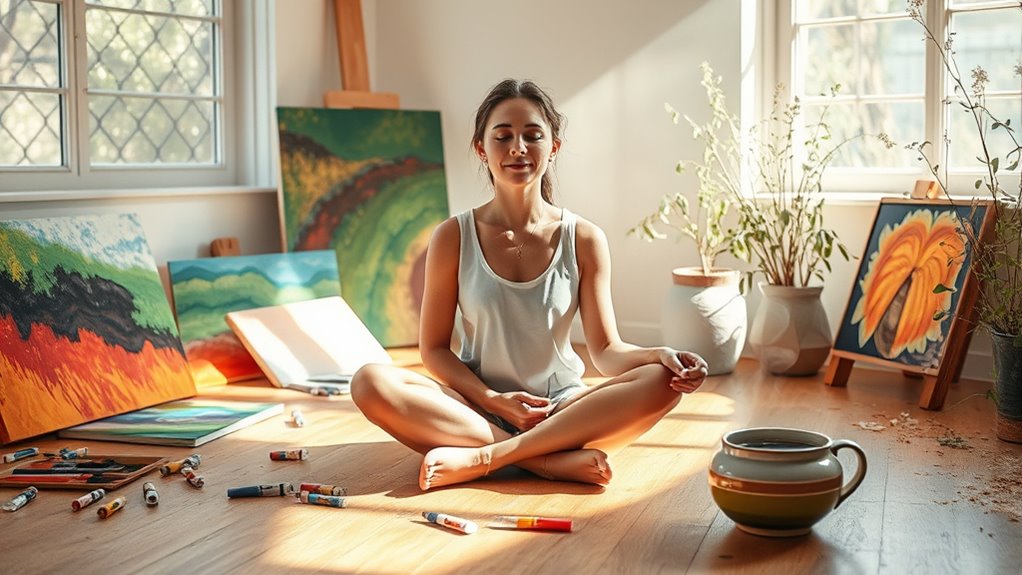
Mindfulness offers a wealth of long-term benefits that can significantly enhance your artistic growth.
By practicing mindfulness, you’ll boost your creativity and cognitive function, allowing you to generate diverse ideas and explore new artistic possibilities. You’ll find that mindfulness reduces stress and anxiety, helping you approach your work with a calm mindset, which can lead to deeper self-expression and more authentic creations.
Improved focus and concentration will keep you engaged and minimize distractions during your creative process. Additionally, mindfulness promotes relaxation, contributing to better sleep and overall mental well-being, essential for maintaining motivation.
Embracing mindfulness can inspire fresh perspectives and ideas, ensuring a consistent flow of inspiration and enhancing your artistic productivity over time.
Frequently Asked Questions
How Long Does It Take to See Benefits From Mindfulness Practice?
You can start seeing benefits from mindfulness practice in just a few days, even with just ten minutes a day. Short sessions can reduce stress and improve your overall well-being almost immediately.
As you practice consistently, you’ll notice more significant changes, like enhanced focus and emotional resilience, within several weeks. Long-term commitment can deepen these benefits, leading to lasting positive effects on your mental health and cognitive flexibility.
Stay consistent, and you’ll reap the rewards.
Can Mindfulness Practices Be Done Alone, or Do I Need Guidance?
Sure, you can totally meditate like a lone wolf, right? Just sit in silence, channel your inner guru, and hope for enlightenment.
But, let’s get real. While solo mindfulness practices are absolutely doable, guidance helps you avoid pitfalls like wandering thoughts or napping instead of meditating.
A little direction can enhance your experience, helping you stay focused and deepen your practice.
Are There Specific Mindfulness Exercises for Different Art Forms?
Yes, there are specific mindfulness exercises tailored for different art forms.
For instance, while painting, you can focus on the colors and textures, immersing yourself in the experience.
In knitting or crocheting, the repetitive motions help you achieve a calm state.
When photographing, tune into your surroundings to capture the moment.
Each art form offers unique ways to engage your senses and promote mindfulness, allowing you to be present and fully enjoy the creative process.
How Can I Measure My Mindfulness Progress as an Artist?
To measure your mindfulness progress, start by keeping a journal where you document your thoughts and feelings during creative sessions.
Reflect on your experiences regularly, noting any changes in your focus and emotional responses.
You could also set specific goals for your art practice and assess how well you meet them.
Engaging with peers for feedback can help you gain insight into your growth and areas needing improvement, enhancing your mindfulness journey.
Is Mindfulness Suitable for All Types of Artists and Creative Individuals?
Mindfulness is like a gentle breeze that can refresh any artist’s spirit.
It’s suitable for all types of creative individuals, no matter your medium. Engaging in mindfulness can enhance your focus, reduce anxiety, and spark your creativity.
Whether you’re painting, dancing, or writing, incorporating mindfulness practices helps you connect deeply with your work.
Conclusion
So, you’ve mastered the art of creating, but have you considered the art of being present? It’s ironic, isn’t it? In a world that glorifies busyness, taking a moment to breathe can seem counterproductive. Yet, embracing mindfulness can unlock your creative potential in ways relentless hustle never could. By slowing down, you’ll find that your art flourishes, stress diminishes, and your connection to your work deepens. Sometimes, less really is more—who knew?

